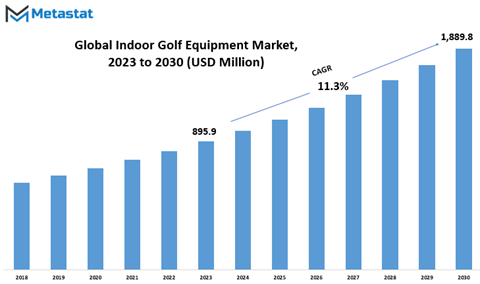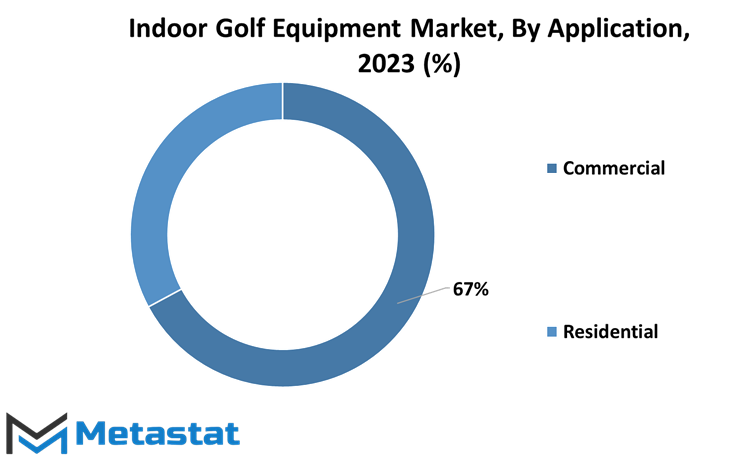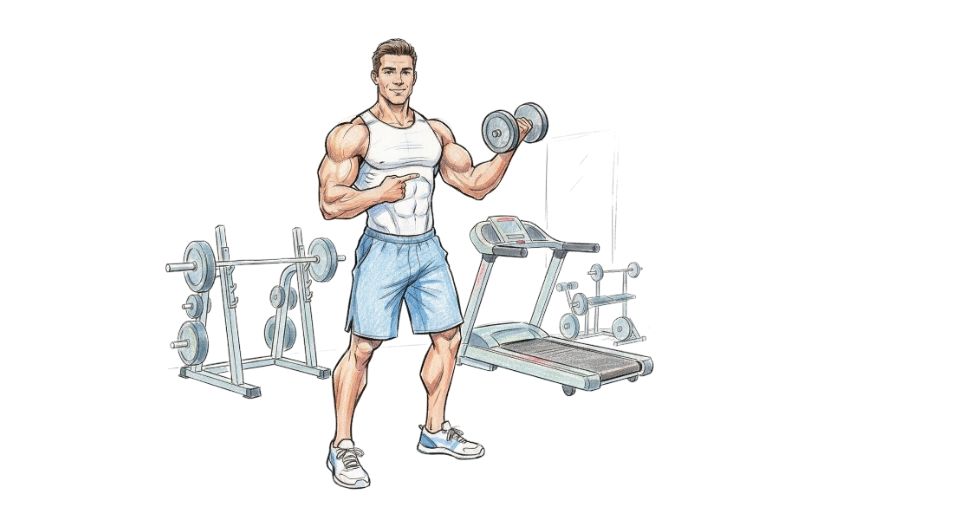MARKET OVERVIEW
The Global Indoor Golf Equipment market has witnessed a remarkable surge in popularity due to its unique capacity to transcend the limitations of weather and location. In essence, it brings the vast expanse of the golf course into the controlled environment of an indoor space, revolutionizing the way enthusiasts engage with the sport. This transformation has profound implications for both seasoned golfers and newcomers to the game, providing an accessible and immersive avenue to hone skills or initiate a journey into the world of golf.
The significance of the Global Indoor Golf Equipment market extends beyond mere convenience. It serves as a catalyst for skill development, allowing players to practice and refine their techniques consistently, irrespective of external factors. This is particularly vital for professional golfers seeking to maintain their edge in a highly competitive field. Moreover, the accessibility factor contributes to the democratization of golf, enabling a broader demographic to engage with the sport without being constrained by geographical or climatic conditions.
Indoor golf equipment’s importance is underscored by its role in fostering a sense of community among golf enthusiasts. Simulators, for instance, facilitate virtual tournaments and collaborative gaming experiences, fostering camaraderie among players who may be physically distant. This interconnectedness not only amplifies the enjoyment of the game but also opens avenues for skill exchange and friendly competition on a global scale.
Global Indoor Golf Equipment market is estimated to reach $ 1,889.8 Million by 2030; growing at a CAGR of 11.3% from 2023 to 2030.

GROWTH FACTORS
The Indoor Golf Equipment Market marked by various factors influencing its dynamics. Notably, the market has witnessed a surge in popularity attributed to the increasing adoption of indoor golf simulators. These simulators have become a preferred choice for golf enthusiasts, offering a convenient and weather-independent alternative to traditional outdoor play.
One significant driver behind the market's growth is the escalating demand for home-based golf training solutions. With the convenience of practicing golf swings and techniques within the confines of one's home, individuals are turning to indoor golf equipment to hone their skills. This shift in consumer behavior has propelled the market forward, with a rising number of enthusiasts seeking accessible and efficient training options.
However, a notable challenge faced by the Indoor Golf Equipment Market revolves around the limited availability of realistic golf simulators. While the demand for indoor golf experiences has surged, the supply of high-quality simulators capable of providing an authentic golfing feel has not kept pace. This gap between demand and supply poses a hurdle for the market's seamless expansion.
Another aspect influencing the market is the high cost associated with indoor golf equipment. The investment required for setting up a comprehensive indoor golf setup, including simulators, hitting mats, and related technologies, can be substantial. This financial barrier may impede widespread adoption, particularly among individuals with budget constraints, thereby affecting the market's overall penetration.
In tandem with the market's evolution, there is a discernible trend fueled by the rising interest in virtual and augmented reality (VR and AR) technology. This technology has found applications in the indoor golf domain, enhancing the overall experience for users. Virtual environments, mimicking real golf courses, coupled with augmented reality elements, contribute to a more immersive and engaging practice session.
The amalgamation of virtual and augmented reality into indoor golf equipment aligns with the broader technological trends in the recreational and sports industry. This integration not only caters to the entertainment aspect but also serves as a valuable tool for skill development. The appeal of a more interactive and technologically advanced golfing experience further propels the market's attractiveness.
MARKET SEGMENTATION
By Type
The Indoor Golf Equipment Market offers a diverse range of products designed to enhance the golfing experience within indoor settings. This market is categorized into various types, with Golf Simulator, Golf Putting Green, Golf Mat, Golf Net, and others being key segments.
The Golf Simulator, a prevalent type, provides a virtual golfing experience, allowing enthusiasts to practice and play in simulated environments. This technology combines entertainment with skill development, catering to both beginners and seasoned golfers seeking a dynamic indoor experience.
Golf Putting Greens, another segment, focuses on refining putting skills. These are portable or fixed structures that simulate real putting surfaces, enabling golfers to work on precision and control conveniently indoors.
Golf Mats, a fundamental component, mimic the feel of a golf course surface, providing a platform for practicing various shots. They are crucial for maintaining one's swing and technique regardless of weather conditions.
Golf Nets, a popular choice for indoor spaces, serve as protective barriers, preventing stray shots. They are particularly valuable for confined environments where space is limited, ensuring a safe and controlled golf practice setting.
By Application
Beyond the types, the market diversifies further based on application, primarily into Commercial and Residential categories.
The Commercial sector encompasses golf facilities, training centers, and entertainment venues. Golf Simulators, with their immersive experience, find a place in commercial settings, offering customers a unique golfing encounter. Additionally, Golf Mats and Putting Greens cater to the commercial demand for versatile training equipment.
On the other hand, the Residential segment caters to individual golf enthusiasts looking to create a personalized golf practice space within their homes. Golf Nets become essential here, providing a secure environment for practicing shots without the need for extensive outdoor space. Golf Simulators may also find a place in high-end residential setups, allowing individuals to enjoy a virtual golfing experience from the comfort of their homes.

REGIONAL ANALYSIS
The global Indoor Golf Equipment market is categorized into distinct regions, primarily North America and Europe, based on geographical considerations. This division is crucial in understanding the market dynamics and preferences within specific geographic locations.
North America, a key player in the Indoor Golf Equipment market, encompasses a diverse range of consumer preferences and market trends. The region's economic prowess and the population's inclination towards leisure activities contribute significantly to the market's growth. In this context, indoor golfing, as a recreational sport, finds resonance among North American consumers, propelling the demand for related equipment.
Similarly, Europe, with its rich cultural diversity, showcases unique market characteristics for Indoor Golf Equipment. Different countries within the continent exhibit varying degrees of interest and engagement in indoor golfing. Factors such as climate, lifestyle, and the cultural significance attached to golf influence the market trends in different European regions.
Analyzing the geographical segmentation offers insights into the specific needs and demands of consumers in North America and Europe regarding indoor golfing equipment. This understanding is pivotal for market players, enabling them to tailor their products and strategies according to the distinct preferences and trends prevalent in these regions.
Moreover, the geographical division provides a nuanced perspective on the competitive landscape. Regional competitors, regulations, and market dynamics play a crucial role in shaping the Indoor Golf Equipment market in North America and Europe. Companies operating in these regions need to navigate the unique challenges and opportunities posed by each geographical segment, making strategic decisions that align with the local market intricacies.
COMPETITIVE PLAYERS
The Indoor Golf Equipment market, a sector marked by the presence of key players like GOLFZON and Full Swing Golf, showcases a competitive landscape where innovation and technological advancements are pivotal. These companies have established their prominence by offering cutting-edge solutions in the indoor golf equipment domain.
GOLFZON, a notable player in the industry, has distinguished itself through a commitment to providing state-of-the-art indoor golf simulators. These simulators replicate the on-course experience with remarkable accuracy, allowing enthusiasts to enjoy the game within the confines of indoor spaces. GOLFZON's offerings encompass a spectrum of features, from realistic graphics to precision in swing analysis, catering to both beginners and seasoned golfers.
Similarly, Full Swing Golf stands as a key contender in the Indoor Golf Equipment market. Renowned for its comprehensive range of golf simulation technologies, Full Swing Golf has etched its name in the industry. The company's emphasis on realism sets its products apart, offering users an immersive golfing experience. Full Swing Golf's simulators are equipped with advanced sensors and high-speed cameras, ensuring precise ball and club data for an authentic feel.
In the competitive milieu of the Indoor Golf Equipment market, these key players continually push boundaries in enhancing user experience. The integration of cutting-edge technologies, such as virtual reality and artificial intelligence, further underscores the industry's trajectory towards creating a more immersive and engaging golfing environment.
As technology continues to advance, the Indoor Golf Equipment market is witnessing a transformation. Beyond traditional simulators, companies explore innovations like interactive screens, augmented reality features, and enhanced connectivity. This evolution aligns with the growing demand for indoor golfing solutions that not only refine skills but also offer a social and entertaining dimension to the experience.
Consumer preferences, shaped by a desire for convenience and year-round accessibility to the sport, fuel the momentum of the Indoor Golf Equipment market. Key players like GOLFZON and Full Swing Golf are attuned to these trends, steering their product development to meet the evolving needs of the market. The result is a dynamic landscape where competition fosters continuous improvements in equipment capabilities and features.
The Indoor Golf Equipment market, dominated by influential players like GOLFZON and Full Swing Golf, epitomizes the intersection of technology and recreational sports. The industry's competitive dynamics are characterized by a commitment to innovation, creating a space where golf enthusiasts can enjoy the sport in a virtual setting that mirrors the authenticity of a golf course. As these key players drive advancements, the Indoor Golf Equipment market remains a vibrant arena for both manufacturers and consumers alike, promising a future where the love for golf transcends traditional boundaries.
Indoor Golf Equipment Market Key Segments:
By Type
- Golf Simulator
- Golf Putting Green
- Golf Mat
- Golf Net
- Others
By Application
- Commercial
- Residential
Key Global Indoor Golf Equipment Industry Players
- GOLFZON
- Full Swing Golf
- SG Golf
- Okongolf
- SkyTrak
- AboutGolf
- Big Moss
- TrackMan
- Bravo
- Foresight Sports
- T-UP
- TruGolf
- Optishot
- Greenjoy
- Fiberbuilt Golf
WHAT REPORT PROVIDES
- Full in-depth analysis of the parent Industry
- Important changes in market and its dynamics
- Segmentation details of the market
- Former, on-going, and projected market analysis in terms of volume and value
- Assessment of niche industry developments
- Market share analysis
- Key strategies of major players
- Emerging segments and regional growth potential








 US: +1 3023308252
US: +1 3023308252






